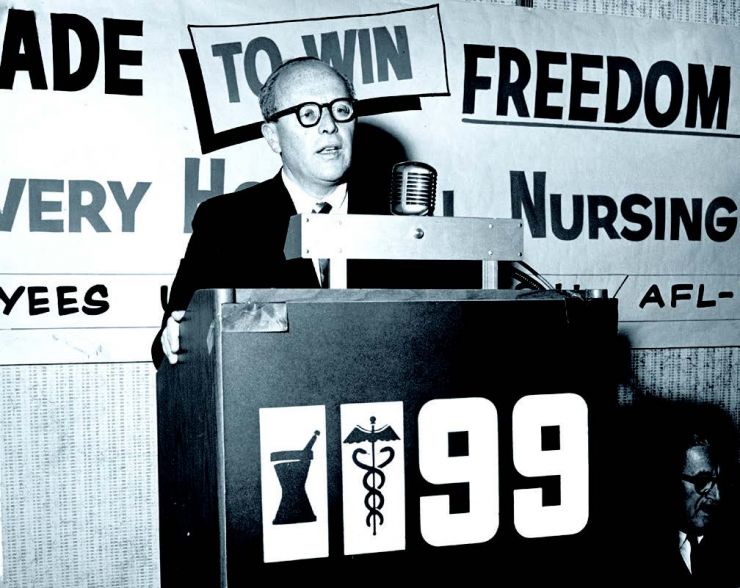Solidarity Forever
January 9, 2025
1199 has always been a fighting force for workers, even during the toughest times.

From 1932 until the onset of McCarthyism and the Red Scare in the late 1940s – the political persecution of left-wing unionists and activists – the union’s forward march was generally in step with President Roosevelt’s New Deal policies.
It’s political and legislative work was carried out in conjunction with other progressive unions, particularly those in the Congress of Industrial Organization (CIO).
The union of pharmacy workers never numbered more than 4,000, but it was generally viewed as a scrappy battler that was able to punch above its weight.
Most of the CIO unions were destroyed or greatly weakened during the McCarthyite Red Scare. But 1199’s unity within the ranks, as well as solidarity with other progressive unions and the community, helped it withstand the attacks.
Key to the union’s ability to survive and actually grow its membership from about 4,000 in 1947 to 6,000 in 1957, was its relationship with the Black community. Leon Davis, 1199’s first president, developed lasting friendships with Black pharmacy workers when he began work in 1927 as a porter and stock clerk in Harlem drugstores.
The Harlem membership is credited with saving the union in 1948 and 1949 when Black workers closed up stores to block certification by a raiding union. A short while later, the same pharmacists hid Davis and the union’s treasurer to prevent the serving of a court subpoena to end a strike.
That solidarity was essential to 1199’s dramatic growth in the 1960s. A similar bond was also developed with the Latino—primarily Puerto Rican—communities. The public face of the union was a well-trained delegate body that saw clearly the connection between rights on the job and rights in the community.
When asked to define the union’s goal at the time, Elliot Godoff, the chief architect of the hospital organizing campaign, declared, “Rights! Rights! Rights!”
The union was not always able to replicate its New York victories.
In 1969, during its foray into the South,1199 helped change the status of African Americans in Charleston, South Carolina, but it failed to win full union recognition.
Organizers drew lessons from the campaign, however, and starting in Maryland used the momentum to win organizing campaigns across the nation.
In November 1973, 1199 was the only union in the nation to strike against President Richard Nixon’s Cost of Living Council. The strike limited the Council’s reduction of the union’s contractual wage increase.
In the 1980s, during Republican President Ronald Reagan’s frontal attack on labor, the “Save Our Union” coalition of rank-andfilers and former staff captured leadership of the union. The movement returned the union to its progressive path that led to unprecedented growth and increased political power.
That growth and power multiplied in 1998 when 1199 merged with the powerful Service Employees International Union (SEIU). That affiliation helped the union survive eight years of the George W. Bush administration, as it did during the single term of George H.W. Bush from 1989 to 1993.
That the Union was able to prosper under hostile political administrations is attributed to its operative slogan, “an injury to one is an injury to all.”
Another hallmark is democracy.
All members have a voice regardless of race, ethnicity, gender, sexual orientation or political affiliation.
Leon Davis is quoted as saying, “How is it that these workers were able to overcome the many obstacles that divided them? The struggle to overcome these obstacles is the real story of 1199.”
The union grew to include the majority of the world’s nationalities. This includes members who hail from nations with large activist unions. These members bring important experiences that deepen diversity and enrich 1199. And that diversity has become key to the union’s political and legislative work.
As 1199 grew to the largest health care union in the nation, it also developed into one of the most politically powerful. It did so through the mass mobilization of its membership and tens of thousands of contributors to its Martin Luther King, Jr. Political Action Fund.
Twenty years ago, some 5,000 members of 1199 worked nationwide to get out the vote for U.S. Senator John Kerry on Election Day, one of the largest mobilizations of a union at the time. George W. Bush was re-elected, but 1199ers did not hang their heads.
“We still have hope for a brighter future, said Edna Warner, a New York Hero dispatched to Cincinnati, Ohio. I’m so proud of what we’ve done. We can take the knowledge and wisdom we’ve gained from this to other campaigns.”
Four years later, 1199 stepped up its mobilization efforts and its work with union allies to elect Barack Obama—the nation’s first Black president.
The work doesn’t stop—this era will educate people about the right to vote.

